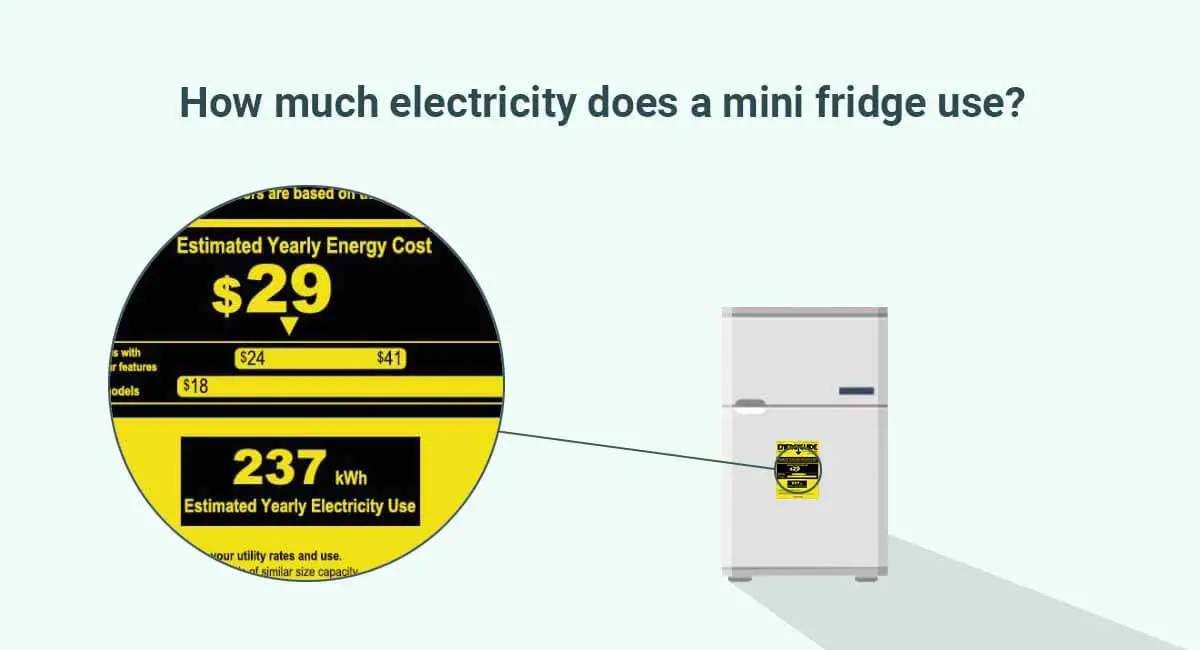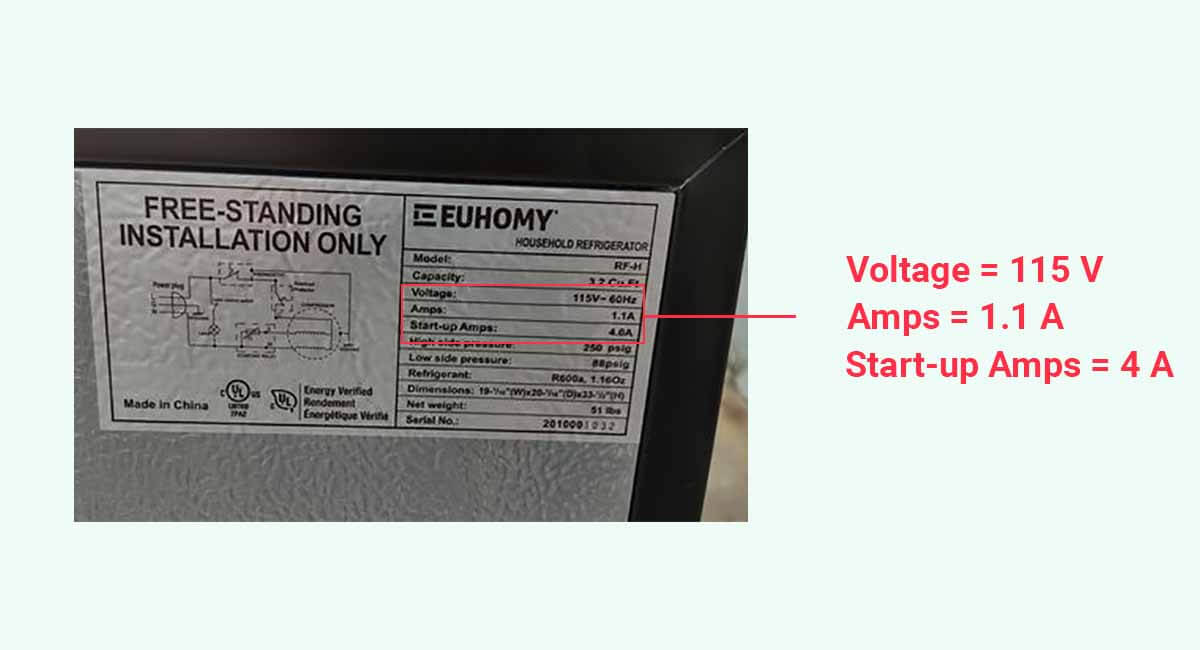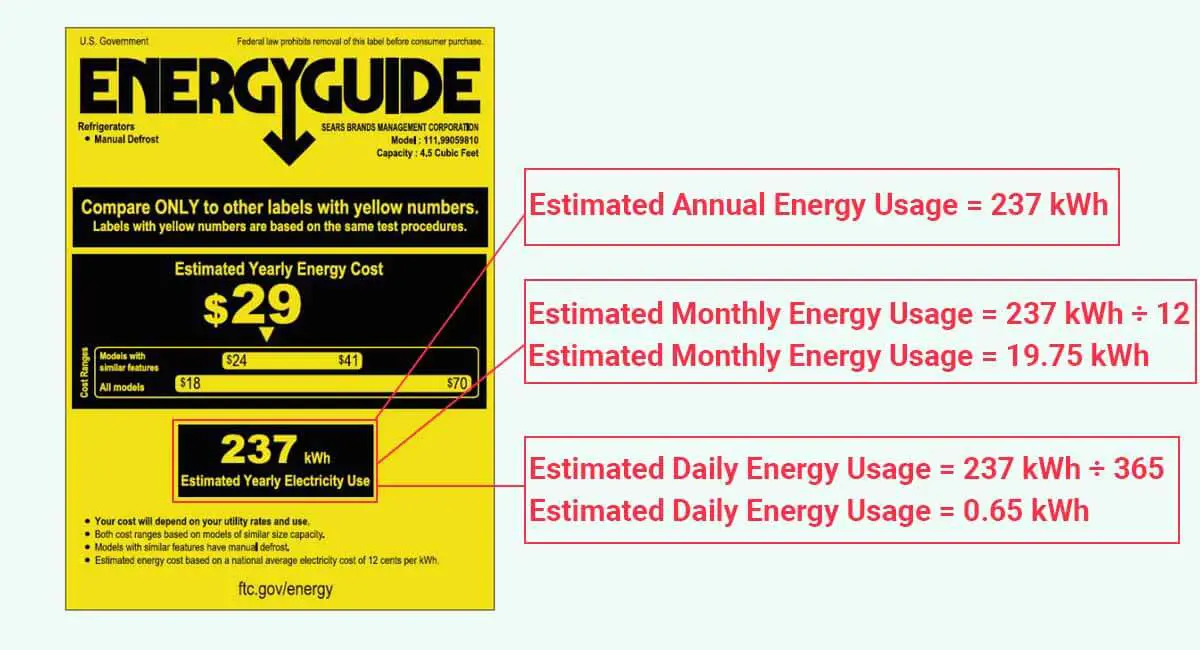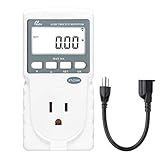
I get commissions for purchases made through links in this post.
How much electricity does a mini fridge use?
When determining the electricity usage of a mini fridge, or any appliance for that matter, it’s crucial to differentiate between two main aspects of electrical usage:- Power Usage (measured in Watts or kilowatts): This refers to the rate at which the mini fridge utilizes electricity. For instance, when its compressor is running, a mini fridge may be using around 70 Watts of power at a given moment.
- Energy Consumption (measured in Watt-hours or kilowatt-hours): This represents the actual amount of electricity the mini fridge consumes over a specific period. For example, it could be said that a mini fridge consumes 800 Watt-hours (Wh) or 0.8 kilowatt-hours (kWh) of energy per day.
How much power, or how many watts, does a mini fridge use?
The power usage of a mini fridge can vary based on the model and size. On average, a mini fridge will use between 60 and 120 Watts of power continuously while it’s running. However, during the startup process, the mini fridge may have a momentary spike in power usage, ranging from 300 to 600 Watts. It’s worth noting that older mini fridges tend to be less efficient than newer models and may have higher power requirements.Mini-fridges
- The Rated Voltage (in Volts or “V” for short) of the mini fridge (typically 110-130 Volts in the U.S.)
- The Rated Current or Amperage (in Amps or “A” for short) of the mini-fridge.
 To determine its power usage (in Watts), we’ll multiply the Rated Current of the mini fridge (indicated as “Amps”) by its Rated Voltage:
Rated Power (Watts) = Rated Voltage (Volts) x Rated Current (Amps)
Rated Power (Watts) = 115 Volts x 1.1 Amps
Rated Power (Watts) = 126.5 Watts
The power usage that we’ve just calculated can be used to size the appropriate equipment that would be required to run the mini fridge.
For example, if we wanted to choose an inverter that can run the refrigerator, the inverter would have to have a Continuous Power rating of more than 126.5 Watts.
Notice that the manufacturer of this particular mini fridge mentions an additional Amperage specification, indicated as “Start-up” Amps and specified as 4 Amps.
This additional amperage rating refers to the maximum amount of current that the mini fridge is likely to draw at start-up. Along with the Voltage of the mini fridge, this rating can be used to calculate to amount of power that the mini fridge requires to start:
Start-up Power (Watts) = Rated Voltage (Volts) x Start-up Current (Amps)
Start-up Power (Watts) = 115 Volts x 4 Amps
Start-up Power (Watts) = 460 Watts
This “Start-up Power” that we’ve just calculated should also be taken into consideration when sizing equipment.
For example, an inverter that can this mini fridge has to have a Surge (Peak) Power rating of more than 460 Watts.
If you’d like to learn more about sizing inverters for refrigerators, feel free to check out this detailed post I wrote.
To determine its power usage (in Watts), we’ll multiply the Rated Current of the mini fridge (indicated as “Amps”) by its Rated Voltage:
Rated Power (Watts) = Rated Voltage (Volts) x Rated Current (Amps)
Rated Power (Watts) = 115 Volts x 1.1 Amps
Rated Power (Watts) = 126.5 Watts
The power usage that we’ve just calculated can be used to size the appropriate equipment that would be required to run the mini fridge.
For example, if we wanted to choose an inverter that can run the refrigerator, the inverter would have to have a Continuous Power rating of more than 126.5 Watts.
Notice that the manufacturer of this particular mini fridge mentions an additional Amperage specification, indicated as “Start-up” Amps and specified as 4 Amps.
This additional amperage rating refers to the maximum amount of current that the mini fridge is likely to draw at start-up. Along with the Voltage of the mini fridge, this rating can be used to calculate to amount of power that the mini fridge requires to start:
Start-up Power (Watts) = Rated Voltage (Volts) x Start-up Current (Amps)
Start-up Power (Watts) = 115 Volts x 4 Amps
Start-up Power (Watts) = 460 Watts
This “Start-up Power” that we’ve just calculated should also be taken into consideration when sizing equipment.
For example, an inverter that can this mini fridge has to have a Surge (Peak) Power rating of more than 460 Watts.
If you’d like to learn more about sizing inverters for refrigerators, feel free to check out this detailed post I wrote.
Electricity Usage Monitors
How much energy, or how many kiloWatt-hours (kWh), does a mini fridge use?
The energy consumption of a mini fridge can vary based on factors like its size, efficiency, and patterns of usage. On average, a mini fridge typically consumes between 200 and 300 kWh (kiloWatt-hours) of energy per year, equivalent to approximately 15 to 25 kWh per month or 0.55 to 0.85 kWh per day. To provide a better understanding, let’s compare the energy consumption of different mini fridge models in the table below:| Model | Size (Cu. ft.) | Estimated Annual Energy Consumption (kilo-Watt-hours) | Estimated Monthly Energy Consumption (kiloWatt-hours) | Estimated Daily Energy Consumption (kiloWatt-hours) |
| 1.7 Cu. ft. | 202 kWh/year | 16.8 kWh/month | 0.55 kWh/day | |
| 2.5 Cu. ft. | 212 kWh/year | 17.7 kWh/month | 0.58 kWh/day | |
| 3.2 Cu. ft. | 219 kWh/year | 18.25 kWh/month | 0.6 kWh/day | |
| 4.4 Cu. ft | 268 kWh/year | 22.3 kWh/month | 0.74 kWh/day | |
| Kenmore 99059 | 4.5 Cu. ft. | 237 kWh/year | 19.75 kWh/month | 0.65 kWh/day |
Mini-fridges
 The manufacturer estimates its energy consumption to be approximately 237 kWh per year. By dividing this value by 12, we can estimate the monthly energy consumption, or by 365 for the daily energy consumption.
While this approach provides quick energy consumption estimates, another rule of thumb can be used:
Daily Energy Consumption (Watt-hours) = Rated Power (Watts) x 8 (hours)
For a mini fridge with a Rated Power of 126.5 Watts, we can estimate its daily energy consumption as follows:
Daily Energy Consumption (Watt-hours) = Rated Power (Watts) x 8 (hours)
Daily Energy Consumption (Watt-hours) = 1012 Watt-hours (Wh)
Daily Energy Consumption (kiloWatt-hours) = 1.012 kiloWatt-hours (kWh)
Please note that actual energy consumption may vary depending on factors like temperature, usage patterns, and efficiency. Nonetheless, this rule of thumb should provide a reasonably accurate approximation.
The most accurate way to determine the energy consumption of your mini fridge would be to actually measure it. This can be done using an electricity monitoring device, such as the kill-A-Watt meter.
The manufacturer estimates its energy consumption to be approximately 237 kWh per year. By dividing this value by 12, we can estimate the monthly energy consumption, or by 365 for the daily energy consumption.
While this approach provides quick energy consumption estimates, another rule of thumb can be used:
Daily Energy Consumption (Watt-hours) = Rated Power (Watts) x 8 (hours)
For a mini fridge with a Rated Power of 126.5 Watts, we can estimate its daily energy consumption as follows:
Daily Energy Consumption (Watt-hours) = Rated Power (Watts) x 8 (hours)
Daily Energy Consumption (Watt-hours) = 1012 Watt-hours (Wh)
Daily Energy Consumption (kiloWatt-hours) = 1.012 kiloWatt-hours (kWh)
Please note that actual energy consumption may vary depending on factors like temperature, usage patterns, and efficiency. Nonetheless, this rule of thumb should provide a reasonably accurate approximation.
The most accurate way to determine the energy consumption of your mini fridge would be to actually measure it. This can be done using an electricity monitoring device, such as the kill-A-Watt meter.
Do mini fridges use a lot of electricity?
To better understand the energy usage of your mini fridge, it’s helpful to compare it to the typical energy consumption of refrigerators in different sizes:| Fridge type | Size (Cu. ft.) | Average daily energy usage (kWh) |
|
Mini fridge |
4,4 Cu. ft. | 0.55 – 0.85 kWh/day |
|
12v fridge |
1.7 Cu. ft. | 0.25 – 0.4 kWh/day |
|
Residential fridge |
20 Cu. ft. | 1.5 – 2.5 kWh/day |
|
RV fridge |
10 Cu. ft | 1 – 1.5 kWh/day |
| Appliance | Daily usage duration | Average daily energy usage (kWh) |
|
Mini fridge |
24 hours | 0.55 – 0.85 kWh/day |
|
Freezer (11-15 Cu. ft.) |
24 hours | 0.6 – 1 kWh/day |
|
Hot Plate |
1 – 2 hours | 1.5 – 2.5 kWh/day |
|
Electric Kettle |
15 – 30 minutes | 0.5 – 1 kWh/day |
|
TV (40 in) |
4 – 6 hours | 0.3 – 0.5 kWh/day |
|
Laptop Computer |
3 – 5 hours | 0.15 – 0.3 kWh/day |
|
LED lights |
4 – 6 hours | 0.06 – 0.1 kWh/day |
|
Window Air Conditioner (5000 BTUs) |
4 – 6 hours | 1.5 – 2.5 kWh/day |
How much does it cost to run a mini fridge?
In the United States, the monthly electricity cost for most mini fridges ranges between $2.5 and $6.5, totaling $30 to $80 per year. The actual cost of running your mini fridge depends not only on its energy efficiency but also on the electricity prices in your specific area. For instance, using data from the U.S. Energy Information Administration as of March 2023, electricity prices vary across states. Wyoming, for example, has a low rate of 10.6 cents per kilowatt-hour (kWh), while Connecticut has a higher rate of 33.2 cents per kWh. To calculate the cost of running your mini fridge, multiply its energy consumption (in kWh) by the cost per kWh in your area: Monthly Cost ($) = Monthly Energy Consumption (kWh) x Cost per kWh ($/kWh) Annual Cost ($) = Annual Energy Consumption (kWh) x Cost per kWh ($/kWh) For example, if your mini fridge uses 15 kWh of energy per month and the cost of electricity in your area is 20 cents per kWh ($0.2/kWh), the monthly cost to operate the mini fridge would be $3 (15 kWh x $0.2/kWh). To simplify the process, I have created a calculator that estimates the monthly and annual costs of running your mini fridge based on its capacity (in cubic feet) and the electricity prices in your specific area:FAQs:
How many amps does a mini fridge use?
Typically, a standard 120VAC mini fridge consumes around 0.5A to 1A of current while it is running, and during startup, it can briefly draw up to 5 Amps. To find out the specific amperage of your mini fridge, you can refer to its electrical specifications sticker or label. The amperage will be indicated as “Rated Current,” “RLA” (Rated Load Amps), “Rated Amps,” or a similar term.How much solar power to run a mini fridge?
To power a mini fridge using solar energy, you would typically require a solar array that generates around 600 to 900 Watt-hours (Wh) of energy per day. This translates to needing approximately 150 to 250 watts of solar power to operate a mini fridge. It’s important to note that the specific solar power requirements may vary based on the amount of sunlight available in your location. For instance: In Denver, CO, the maximum solar power needed to run a mini fridge would be around 160 Watts, while in Chicago, IL, approximately 200 watts would be necessary. For more detailed information, you can refer to the following article: How Much Solar Power Do I Need to Run a Refrigerator?What kind of solar system do you need to run a mini fridge?
To run a mini fridge on solar, you would need a solar system that consists of:- Solar panels: Typically two to three 100W solar panels
- A solar charge controller: Typically a 20A solar charge controller
- A battery bank: Typically one or two 12V-100Ah batteries
- An inverter: Typically a 500W inverter.
How much solar for a 12V refrigerator?
A common 12V refrigerator (1.7 Cu. ft.) consumes about 400Wh (watt-hours) of energy per day. To power a 12V refrigerator only on solar power you would need a 100W solar panel.How much battery does a 12V refrigerator use?
A 12V refrigerator connected to a 12V car battery (50Ah) would be able to run for 1 to 2 days before the battery is completely depleted. If connected to a 12V-100Ah battery, it could run for 3 to 4 days (depending on temperature, insulation, etc…).Spread knowledge... It's FREE!!










Thank you Younes! Very helpful, straightforward article after searching on the net for a couple of days.